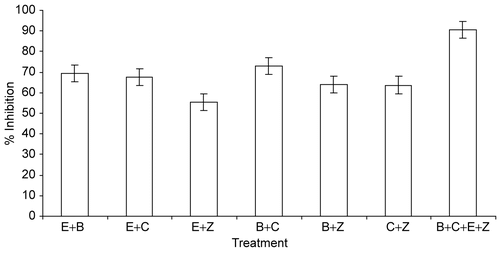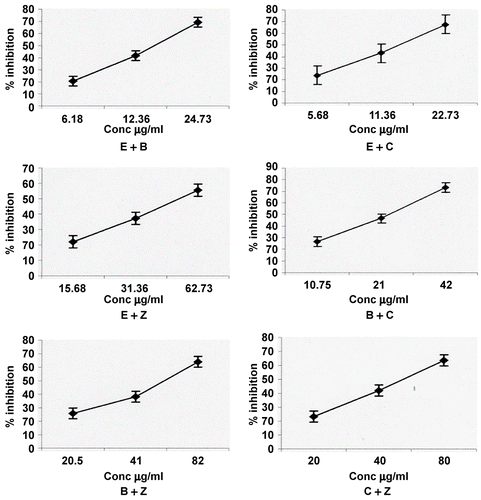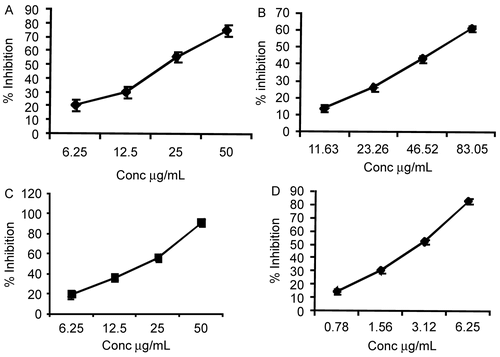Abstract
Herbal medicines are often combinations of herbal extracts that are assumed to have additive or synergistic effects. This investigation compared the effect of individual herbal extracts with combinations of extracts on antioxidant activity by 1,1-diphenyl picryl hydrazyl (DPPH) method and showed the additive or synergistic effects by studying interactions between herbal extracts in combination. Curcuma longa Linn. (Zingiberaceae), Bacopa monneira Linn. Penn. (Scrophulariaceae), Zingiber officinale Rosc. (Zingiberaceae) and Emblica officinalis Gaertn. (Euphorbiaceae) were collected and used to prepare the extracts. Effects of the extracts on DPPH scavenging activity were estimated quantitatively by a UV-spectrophotometeric method. Combinations of two herbal extracts of the four active extracts and their interactions were tested by the DPPH method. Each extract significantly scavenges the free radical activity in a dose-dependent manner. The active extracts of Curcuma longa, Bacopa monneira, Zingiber officinale and Emblica officinalis were tested as two-extract combinations. Curcuma longa and Bacopa monneiera, when combined, showed additive effect with a trend towards synergistic effect, whereas Curcuma longa and Emblica officinalis together were additive. The four extracts together were significantly (p ≤ 0.01) more effective than the two-by-two combinations and the individual extracts alone. The less predictable nature of the two-way combinations suggests a need for careful characterization of the effects of each individual herb based on their intended use.
Introduction
In Indian herbal medicine combinations of natural ingredients are prescribed for the treatment of different disorders. These combinations are intended to attain increased potency due to synergistic interactions between the individual components, such that the combination is superior to individual herbal treatment alone. Creating herbal mixtures as opposed to utilizing a single active herb can present the benefit of lower doses of each individual herb, thus reducing the incidence of dose-related side effects at the same bioeffective dose of a single herb. This treatment philosophy is consistent with the systemic theory of treating chronic diseases, which advocates the inclusion of many active organic substances in formulas to not only treat the disease but to create homeostasis within the body (CitationOlalde et al., 2005).
Curcuma longa Linn. (Zingiberaceae), commonly known as Haridra in Hindi and turmeric in English is used as an antacid, carminative, stomachic and blood purifier, with wound healing, anti-inflammatory, antibacterial, antiviral and antioxidant activities (CitationKhanna, 1999; CitationAmmon & Whal, 1991). It is widely used as the coloring agent in food items, and it is a major component of curry powder. Its medicinal properties have been attributed mainly to the curcuminoids and the main component present in the rhizome includes curcumin, demethoxy curcumin and bis-demethoxy curcumin. Zingiber officinale Rosc. (Zingiberaceae) is commonly known as ‘sunthi’ in Hindi and ginger in English. Ginger is sweet and pungent in taste. It is used as an appetizer, aphrodisiac and carminative. In Ayurveda, it is considered a valuable medicine because of its action as rubifacient, antiasthmatic and stimulant to the gastrointestinal tract (CitationKirtikar & Basu, 1975). Ginger has shown hypolipidemic, anti-inflammatory and antihepatotoxic activity (CitationBhandari et al., 1998, Citation2003; CitationPenna et al., 2003). The main active ingredient present in ginger is 6-gingerol. Emblica officinalis Gaertn. (Euphorbiaceae) is commonly known as Amla in Hindi. The fruits of the plant are fleshy with a sour, astringent taste and are consumed raw, cooked or even pickled locally. The fruits have been reported to possess antioxidant, adaptogenic, hepatoprotective, antitumor, antifungal, antipyretic, analgesic, gastroprotective, hypolipidemic, and antiulcerogenic activities (CitationBhattacharya et al., 1999; CitationRege et al., 1999; CitationJose & Kuttan 2000; CitationJose et al., 2001; CitationDutta et al., 1998; CitationPerianayagam, et al., 2004; CitationAl-Rehailya et al., 2002; CitationMathur et al., 1996; CitationSairam et al., 2002(a); CitationSairam et al., 2002(b)). Bacopa monneira Linn. Penn. (Scrophulariaceae), commonly known as Brahmi, is reported to be useful in the treatment of insanity, epilepsy and as an effective nerve tonic (CitationCSIR, 1959). Its bacosides are used as a memory enhancer (CitationSingh & Dhawan, 1982). Brahmi has been reported to possess antioxidant activity (CitationTripathi et al., 1996).
Interactions between phytochemical substances have been tested in limited fashion in herbal combinations and have the possibility of antagonism as well as synergism effect.
The aim of this present research work is to design and further to assess the actions and interactions of plant extracts from the BCEZ formula (Bacopa monnieri, Curcuma longa, Emblica officinalis and Zingiber officinale) separately and in combination, in a DPPH free radical scavenging antioxidant model. The plants that acquired activity were chosen due to either their inclusion in traditional Indian formulas or based on published reports of their effects in patients and calculated an interaction index for the data and to mathematically compare the observed response. In addition to the two-way combinations, a mixture of the four potent extracts were also tested in the antioxidant assay and compared with the two-way mixtures.
Materials and methods
Plant materials
H.B. Singh of National Institute of Science Comm unication and Information Resources, New Delhi, India authenticated all the plant material used in this study. The authenticated sample of plant material of Bacopa monnieri Linn. Penn. (whole plant, voucher specimen no. NISCAIR/RHMD/Consult/07-08/882/66/4), Curcuma longa Linn. (rhizome, voucher specimen no. NISCAIR/RHM/F-3/2006/Consult/723/40), Emblica officinalis Gaertn. (fruits, voucher specimen no. NISCAIR/RHMD/Consult/06-07/790/107) and Zingiber officinale Rosc. (rhizome, voucher specimen no. NISCAIR/RHM/ F-3/2004/Consult./495/71) were collected from Bangalore in the month of June and provided by Natural Remedies, Bangalore, India.
Preparation of plant extracts
Coarse powder (250 g) of the dried material of Curcuma longa (Linn.), Bacopa monneira (Linn.), Zingiber officinale Rosc. and Emblica officinalis Gaertn. were separately extracted to exhaustion with methanol (900 mL) using a Soxhlet apparatus for 48 hours. The methanol extract thus obtained was dried separately under reduced pressure at room temperature not exceeding 40˚C. All the extracts after drying were dissolved in dimethylsulfoxide (DMSO).
Reagents
Dimethylsulfoxide (99.0%) and methanol (98.8%) analytical grade were purchased from E-Merck, Mumbai, Maharashtra, India, and 1,1-diphenyl-2-picryl hydrazyl (DPPH) was purchased from Sigma, St. Louis, MO.
DPPH assay
The radical-scavenging activity of the extract was determined using the method of CitationSchmeda-Hirschmann et al. (1999). Accurately, 6 mL of DPPH (20 μg/mL) methanolic solution was added to 20 μL of DMSO solution of each extract at room temperature. The mixture was shaken vigorously and absorbance was measured at about 517 nm using Beckman (DU 640B) spectrophotometer. All tests were run in triplicate and mean values were taken for calculation.
Analysis of antioxidant effect and synergism
Inhibitory concentration (IC50) values for each herbal extract were determined through linear regression with the GraphPad Prism 4 software. In combination experiments, extracts were added at equipotent quantities and at 1/2 and 1/4 fractions of their IC50 value. To assess synergy and antagonism, experimentally derived data was used to determine the interaction index according to the method of CitationTallarida (2002).
Interaction index
The assessment of additive and synergistic interaction is most often made from experiments in which an effect level is chosen and doses of drug A alone, drug B alone and the combination (a, b) that give this effect are determined experimentally. The interaction index is denoted by γ. It is calculated by using the following equation.
where A = Dose of one drug alone, B = dose of another drug alone, a = dose of drug A in combination, b = dose of drug B in combination.
If γ = 1, the interaction is additive; if γ < 1 it is synergistic, and if γ > 1 it is sub additive.
Statistical analysis
Results are presented as mean values ± standard error (SE). Data were analyzed by one-way ANOVA to compare experimental means with different combinations using GraphPad Prism 4 software.
Results
Inhibition of free radical activity with individual extracts
Each of the individual extracts significantly scavenges the free radical activity tested in a dose-dependent manner by DPPH method (). The IC50 values obtained for each extract treatment are shown in .
Two-way and four-way combination treatments
Two-way combination studies of the four herbs exhibited varying inhibitory activities in the DPPH scavenging activity. Inhibition of scavenging activity >50% was taken to be indicative of additive or enhanced inhibition of free radicals since all herbal extracts were added at the known concentration of IC50 values. The mixture of B. monneiri and C. longa was the most effective combination treatment, resulting in 73.10% inhibition of scavenging activity compared with other combinations. Similarly, the combination of E. officinalis and C. longa herbal mixture showed 67.48%, B. monneiri and Z. officinale had 64.05% inhibition of scavenging activity. However, when the four herbs were combined into a single treatment (Quad, E, B, C & Z), the result obtained was 90.51% inhibition of scavenging activity ().
Figure 2. Antioxidant activity of different combinations. E,Emblica officinalis; B, Bacopa monneiri; C, Curcuma longa; Z, Zingiber officinale; n = 3 and p ≤ 0.01 for each combination compared to vehicle control.

Table 1. In vitro antioxidant activity of herbal extracts.
Interaction index
Utilizing the IC50 values of each individual herb and the IC50 value of the combinations, the interaction index was derived to evaluate the level of interaction between the two herbs (CitationTallarida, 2002). The dose effective data and statistics for the interaction index is shown in .
Figure 3. Dose effect data of two-way combinations. B, Bacopa monneiri; C, Curcuma longa; E, Emblica officinalis; Z, Zingiber officinale.

The interaction index of B. monneiri and C. longa was somewhat <1 (0.95), therefore it shows the trend towards synergy. The interaction index of E. officinalis and B. monneiri was slightly >1 (1.25) and the interaction index for E. officinalis and C. longa was also >1 (1.26), these two combinations shows additive interaction. Interaction index for E. officinalis and Z. officinale obtained was 1.73, B. monneiri and Z. officinale was 1.46, and C. longa and Z. officinale in combination have an interaction index of 1.38. The results of the interaction indexes are shown in .
Table 2. Interaction index of herbal combinations.
Discussion
The purpose of this investigation was to determine the activity of four widely used natural extracts in DPPH scavenging activity. Secondly, we analyzed the interactions between the different herbs in combination, in an in vitro antioxidant model. These studies demonstrated varying effects of the four individual herbs on antioxidant activity in vitro. These interactions may depend upon the complementary nature of different families of compounds in each of the extracts. This principle was demonstrated for food phytochemical extracts in a recent report which demonstrated that tomato powder containing lycopene, phytoene, phytofluene in a complex mixture, but not purified lycopene, was able to inhibit prostate carcinogenesis in mouse model (CitationBoileau et al., 2003).
The limitations in the proposed work are related to the in vitro method used to evaluate scavenging activity, which may not reflect the conditions in vivo following absorption and metabolism of the extracts. The results of the interaction index suggest that unknown factors influencing the action of the extracts make their interactions unpredictable. The ratio of one extract to another, the mode of action and the necessity of common cellular resources are only some examples of variables that may determine the efficacy of a mixture. Therefore, comprehension of the activity of each extract when alone and in combination is essential for designing effective mixtures.
The results indicate that some of the two-by-two combinations displayed additive effects. More importantly, despite the interactions of the extracts in two-by-two combinations, the overall effect of the absolute mixture of four herbal drugs was to inhibit scavenging activity to 90.51%. This observation is consistent with the idea that combinations of herbal extracts are more effective than isolated components in the mixture.
Acknowledgements
We thank the University Grant Commission (UGC), Government of India, for providing a fellowship to Om Prakash.
Declaration of interest: The authors report no conflicts of interest. The authors alone are responsible for the content and writing of the paper.
References
- Al-Rehailya AJ, Al-Howirinya TS, Al-Sohaibanib MO, Rafatullaha S (2002): Gastroprotective effects of “Amla” Emblica officinalis on in vivo test models in rats. Phytomedicine 9: 515–522.
- Ammon, HPT, Wahl MA (1991): Pharmacology of Curcuma longa. Planta Med 57: 1–7.
- Bhandari U, Sharma JN, Zafar, R (1998): Effect of ethanolic extract of Zingiber officinale on dyslipidaemia in diabetic rats. J Ethnopharmacol 61: 167–171.
- Bhandari U, Shamsher A, Pillai KK, Khan MSY (2003): Antihepatotoxic activity of ginger ethanol extract in rats. Pharm Biol 41: 68–71.
- Bhattacharya A, Chatterjee A, Ghosal S, Bhattacharya SK (1999): Antioxidant activity of active tannoid principles of Emblica officinalis (Amla). Indian J Exp Biol 37: 676–680.
- Boileau T, Clinton SK, Erdman J (2003): Prostate carcinogenesis in N-methyl-N-nitrosourea (NMU)-testosterone-treated rats fed tomato powder, lycopene, or energy-restricted diets. J Nat Cancer Inst 95: 1578–1586.
- CSIR (1959): Wealth of India. Raw Materials, Vol. V. New Delhi, CSIR, p. 108.
- Dutta BK, Rahman I, Das JK (1998): Antifungal activity of Indian plant extracts. Mycosis 41: 535–536.
- Jose JK, Kuttan R (2000): Hepatoprotective activity of Emblica officinalis and chyavanaprash. J Ethnopharmacol 72: 135–140.
- Jose JK, Kuttan G, Kuttan R (2001): Antitumor activity of Emblica officinalis. J Ethnopharmacol 75: 65–69.
- Khanna, NM (1999): Turmeric, Nature’s precious gift. Current Sci 76: 1351–1356.
- Kirtikar KR, Basu BD (1975): Indian Medicinal Plants, Vol. IX, International Book Distributors, Dehradun, pp. 2435–2439.
- Mathur RA, Sharma A, Dixit VP, Varma M (1996): Hypolipidaemic effect of fruit juice of Emblica officinalis in cholesterol-fed rabbits. J Ethnopharmacol 50: 61–68.
- Olalde Rancel J, Magarici M, Amendola F, Del Castillo O (2005): The systemic theory of living systems. Part IV: Systemic medicine-the praxis. Evidence Based Comp Alter Med 2: 429–439.
- Penna SC, Medeiros MV, Aimbire, FSC, Faria-Neto, HCC, Sertie JAA, Lopes-Martins, RAB (2003): Anti-inflammatory effect of the hydroalcholic extract of Zingiber officinale rhizomes on rat paw and skin edema. Phytomedicine 10: 381–385.
- Perianayagam JB, Sharma SK, Joseph A, Christina AJM (2004): Evaluation of anti-pyretic and analgesic activity of Emblica officinalis Gaertn. J Ethnopharmacol 95: 83–85.
- Rege NN, Thatte UM, Dahanukar SA (1999): Adaptogenic properties of six rasayana herbs used in Aurvedic medicine. Phytother Res 13: 275–291.
- Sairam K, Rao CV, Babu MD, Kumar KV, Agrawal VK, Goel RK (2002a): Antiulcerogenic effect of methanolic extract of Emblica officinalis: An experimental study. J Ethnopharmacol 82: 1–9.
- Sairam M, Neetu D, Yogesh B, Anju B, Dipti P, Pauline T, Sharma SK, Sarada, SKS, Ilavazhagan G, Kumar D, Selvamurthy W (2002b): Cyto-protective and immunomodulating properties of Amla (Emblica officinalis) on lymphocytes: An in-vitro study. J Ethnopharmacol 81: 5–10.
- Schmeda-Hirschmann G, Razmilic I, Gutierrez MI, Loyola JI (1999): Proximate composition and biological activity of food plants gathered by Chilean Amerindians. Econ Bot 53: 177–187.
- Singh HK, Dhawan BN (1982): The effect of Bacopa monniera Linn. (Brahmi) extract on avoidance response in rats. J Ethnopharmacol 5: 205–214.
- Tripathi YB, Chaurasia S, Tripathi E, Upadhyay A, Dubey GP (1996): Bacopa monniera Linn. as an antioxidant: Mechanism of action. Indian J Experimental Biol 34: 523–526.
- Tallarida RJ (2002): The Interaction index: A measure of drug synergism. Pain 98: 163–168.
